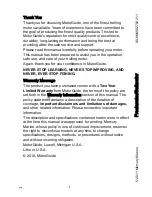
DRV2604L Demonstration Program
www.ti.com
Button 4 uses a series of clicks to create a scroll wheel effect. See the oscilloscope capture in
Figure 15
.
Figure 15. LRA Scroll Wheel Effect Waveform (Button 4)
2.2.5
Mode 1 – Click Waveforms
Mode 1 shows the advantages and disadvantages of the click waveform in the different modes of
operation. Button 1 plays the click waveform with braking in auto-resonance. Button 2 plays the click
waveform with no braking in auto-resonance. It is apparent that braking allows the waveform to dampen
faster so there is no excessive oscillations at the end of the waveform. Button 3 plays the click with
braking but in open loop. Braking is not supported in open loop, thus there is no reverse operation of the
actuator shown in the graph.
Figure 16. LRA Click with Braking in Open Loop
Figure 17. LRA Click with Braking in Auto Resonance
(Button 3)
(Button 1)
2.2.6
Mode 0 – Auto-Calibration
Auto-calibration is a DRV2604L-embedded routine that detects the characteristics and behavior of an
actuator and adjusts the drive waveform automatically.
Perform auto-calibration using the following steps:
1. Connect an actuator to the green output terminal (OUT) or use the on-board actuators
2. For an ERM actuator, run the ERM auto-calibration by pressing button B1
3. For an LRA actuator, run the LRA auto-calibration by pressing button B2
10
DRV2604L ERM, LRA Haptic Driver Evaluation Kit
SLOU390A – May 2014 – Revised June 2014
Submit Documentation Feedback
Copyright © 2014, Texas Instruments Incorporated











































